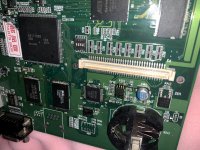Do you also have a stack of old Cave CV-1000 PCBs, and worry about the internal memory of the undumped CPLD at U13 going bad leaving you with an unusable board? Maybe you have a PCB which is already broken due to this?
The CPLD is programmed with device protection enabled, making it hard to dump its content. Luckily it's just a 44 pin device with not too many buses connected to it, so I went ahead and analyzed its behavior and programmed a compatible bitstream that allows you to burn any EPM7032AE CPLD and use that if the original one goes bad. This should allow you to repair a CV-1000 board where U13 has stopped working!
Information about exactly what the CPLD does, and how to make a compatible one for repair is available in this repo: https://github.com/buffis/cv1k_research/tree/main/U13_Research
The docs should be pretty thorough but let me know if you have questions.
NOTE: !!! THIS IS ONLY MEANT FOR REPAIRS FOR DUMB COLLECTORS LIKE ME.
PLEASE KEEP MULTI TALK AND THAT KIND OF STUFF OUT OF HERE !!!
Some pics:



Bonus pic: My cat inspecting my PCBs for failing chips

The CPLD is programmed with device protection enabled, making it hard to dump its content. Luckily it's just a 44 pin device with not too many buses connected to it, so I went ahead and analyzed its behavior and programmed a compatible bitstream that allows you to burn any EPM7032AE CPLD and use that if the original one goes bad. This should allow you to repair a CV-1000 board where U13 has stopped working!
Information about exactly what the CPLD does, and how to make a compatible one for repair is available in this repo: https://github.com/buffis/cv1k_research/tree/main/U13_Research
The docs should be pretty thorough but let me know if you have questions.
NOTE: !!! THIS IS ONLY MEANT FOR REPAIRS FOR DUMB COLLECTORS LIKE ME.
PLEASE KEEP MULTI TALK AND THAT KIND OF STUFF OUT OF HERE !!!
Some pics:
Bonus pic: My cat inspecting my PCBs for failing chips



